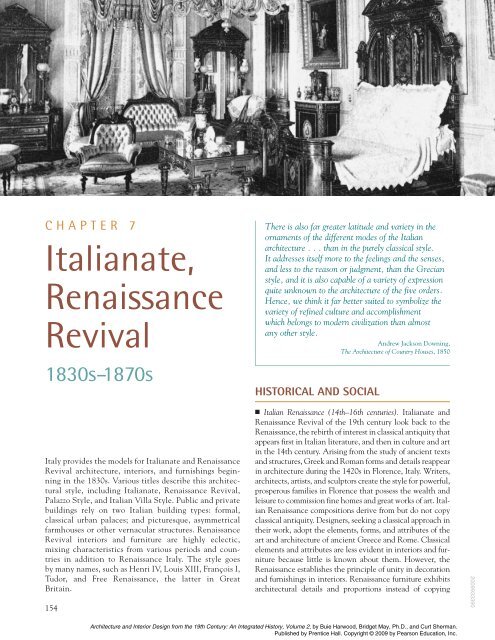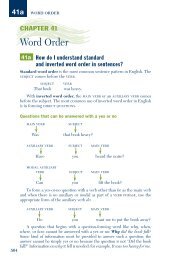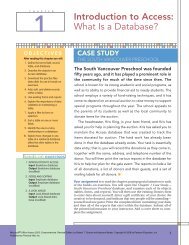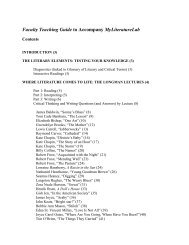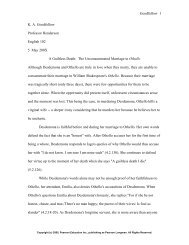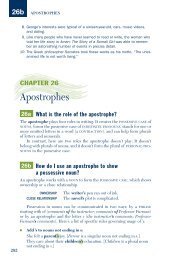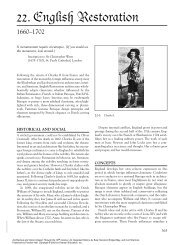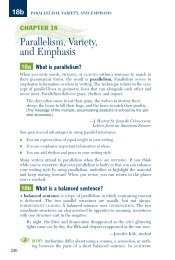Italianate, Renaissance Revival - Pearson
Italianate, Renaissance Revival - Pearson
Italianate, Renaissance Revival - Pearson
Create successful ePaper yourself
Turn your PDF publications into a flip-book with our unique Google optimized e-Paper software.
CHAPTER 7<br />
<strong>Italianate</strong>,<br />
<strong>Renaissance</strong><br />
<strong>Revival</strong><br />
1830s–1870s<br />
Italy provides the models for <strong>Italianate</strong> and <strong>Renaissance</strong><br />
<strong>Revival</strong> architecture, interiors, and furnishings beginning<br />
in the 1830s. Various titles describe this architectural<br />
style, including <strong>Italianate</strong>, <strong>Renaissance</strong> <strong>Revival</strong>,<br />
Palazzo Style, and Italian Villa Style. Public and private<br />
buildings rely on two Italian building types: formal,<br />
classical urban palaces; and picturesque, asymmetrical<br />
farmhouses or other vernacular structures. <strong>Renaissance</strong><br />
<strong>Revival</strong> interiors and furniture are highly eclectic,<br />
mixing characteristics from various periods and countries<br />
in addition to <strong>Renaissance</strong> Italy. The style goes<br />
by many names, such as Henri IV, Louis XIII, François I,<br />
Tudor, and Free <strong>Renaissance</strong>, the latter in Great<br />
Britain.<br />
154<br />
There is also far greater latitude and variety in the<br />
ornaments of the different modes of the Italian<br />
architecture . . . than in the purely classical style.<br />
It addresses itself more to the feelings and the senses,<br />
and less to the reason or judgment, than the Grecian<br />
style, and it is also capable of a variety of expression<br />
quite unknown to the architecture of the five orders.<br />
Hence, we think it far better suited to symbolize the<br />
variety of refined culture and accomplishment<br />
which belongs to modern civilization than almost<br />
any other style.<br />
Andrew Jackson Downing,<br />
The Architecture of Country Houses, 1850<br />
HISTORICAL AND SOCIAL<br />
■ Italian <strong>Renaissance</strong> (14th–16th centuries). <strong>Italianate</strong> and<br />
<strong>Renaissance</strong> <strong>Revival</strong> of the 19th century look back to the<br />
<strong>Renaissance</strong>, the rebirth of interest in classical antiquity that<br />
appears first in Italian literature, and then in culture and art<br />
in the 14th century. Arising from the study of ancient texts<br />
and structures, Greek and Roman forms and details reappear<br />
in architecture during the 1420s in Florence, Italy. Writers,<br />
architects, artists, and sculptors create the style for powerful,<br />
prosperous families in Florence that possess the wealth and<br />
leisure to commission fine homes and great works of art. Italian<br />
<strong>Renaissance</strong> compositions derive from but do not copy<br />
classical antiquity. Designers, seeking a classical approach in<br />
their work, adopt the elements, forms, and attributes of the<br />
art and architecture of ancient Greece and Rome. Classical<br />
elements and attributes are less evident in interiors and furniture<br />
because little is known about them. However, the<br />
<strong>Renaissance</strong> establishes the principle of unity in decoration<br />
and furnishings in interiors. <strong>Renaissance</strong> furniture exhibits<br />
architectural details and proportions instead of copying<br />
Architecture and Interior Design from the 19th Century: An Integrated History, Volume 2, by Buie Harwood, Bridget May, Ph.D., and Curt Sherman.<br />
Published by Prentice Hall. Copyright © 2009 by <strong>Pearson</strong> Education, Inc.<br />
2009933390
2009933390<br />
ancient examples. Warfare, travel, and books spread Italian<br />
concepts to France, Spain, and England where they first<br />
appear as decorative elements grafted onto Gothic and<br />
indigenous forms. Each country gradually assimilates<br />
<strong>Renaissance</strong> design principles, but its interpretation of them<br />
is unique.<br />
■ <strong>Italianate</strong> or Italian Villa Style. In the early 19th century,<br />
the Picturesque Movement inspires English designers to<br />
explore alternatives to classicism, Gothic, and other styles<br />
of the Middle Ages. Some turn to Italian vernacular farmhouses<br />
whose asymmetry, irregularity, and rambling forms<br />
are appealing and picturesque, yet Italian. By the 1830s,<br />
Italian Villa–style country houses and train stations<br />
become more common in England. In the 1840s, the style<br />
is given royal approval by Osbourne House (Fig. 7-12), a<br />
seaside home for Queen Victoria and Prince Albert<br />
enlarged in the style beginning in 1845.<br />
Publications spread the <strong>Italianate</strong> style to North<br />
America, with the first examples appearing in the late<br />
1830s. During the early 1840s, its use increases after writer<br />
and design critic Andrew Jackson Downing begins to advocate<br />
the style as a rural alternative to classical and<br />
Gothic. He publishes examples by Alexander Jackson<br />
Davis of what he calls Italian Villas, <strong>Italianate</strong>, Tuscan Villas,<br />
Lombard Style, or the Bracketed style in several of his<br />
books beginning with Cottage Residences (1842). Although<br />
he regards <strong>Italianate</strong> as somewhat inferior to Gothic,<br />
Downing nevertheless praises it for its interesting appearance,<br />
freedom in planning, and refined cultural ties.<br />
■ <strong>Renaissance</strong> <strong>Revival</strong>. In the early 1830s, Sir Charles Barry<br />
initiates the <strong>Renaissance</strong> <strong>Revival</strong> (or Palazzo Style) in England<br />
by turning to Italian <strong>Renaissance</strong> urban palaces for<br />
inspiration. By the end of the decade, High <strong>Renaissance</strong><br />
palaces define gentlemen’s clubs, a few country houses,<br />
banks, and commercial buildings across England. The<br />
style spreads to North America during the 1840s where it<br />
soon is used mainly for public buildings and commercial<br />
structures.<br />
CONCEPTS<br />
The Italian <strong>Renaissance</strong> offers new inspiration for designers,<br />
who are weary of the Neoclassical columns and porticoes and<br />
are searching for a richer, more plastic alternative to the spare<br />
Greek <strong>Revival</strong>. High <strong>Renaissance</strong> Roman, Florentine, and<br />
Venetian urban palaces become models for the <strong>Italianate</strong><br />
or Palazzo Style in England and <strong>Renaissance</strong> <strong>Revival</strong> in<br />
America, collectively known as <strong>Renaissance</strong> <strong>Revival</strong>. In contrast<br />
to earlier, architects are not primarily interested in the<br />
order, harmony, and proportions of Italian examples. Instead,<br />
they view the style as an expression of Italian refinement and<br />
culture as well as wealth and luxury. <strong>Renaissance</strong> Italy further<br />
appeals because it is nearer to their homelands and time than<br />
the remote, somewhat obscure, classical antiquity.<br />
ITALIANATE, RENAISSANCE REVIVAL 155<br />
IMPORTANT TREATISES<br />
In contrast to the more formal and classical <strong>Renaissance</strong><br />
<strong>Revival</strong>, the <strong>Italianate</strong> and the Italian Villa styles derive<br />
from vernacular Italian farmhouses, villas, and churches.<br />
Primarily residential, this picturesque style is an alternative<br />
to Gothic <strong>Revival</strong>, offering asymmetry and freedom in<br />
design without the religious or moral overtones of Gothic.<br />
<strong>Renaissance</strong> <strong>Revival</strong> interiors and furniture draw upon<br />
Italian, French, German, English, and Northern European<br />
<strong>Renaissance</strong> and Mannerist forms and motifs. Like architecture,<br />
they express refinement and culture. Designers adapt<br />
and reuse forms and motifs, not to replicate past glories, but<br />
to create something new and uniquely of the period.<br />
DESIGN CHARACTERISTICS<br />
� 7-1. Man and woman;<br />
published in the London<br />
Illustrated News,<br />
July–December 1862.<br />
■ Édifices de la Rome moderne, 1840–1857; Paul<br />
Letarouilly.<br />
■ An Encyclopedia of Cottage, Farm, and Villa<br />
Architecture and Furniture, 1833; John Claudius<br />
Loudon.<br />
■ An Essay on the Present State of Architectural<br />
Study and the <strong>Revival</strong> of the Italian Style,<br />
1839; W. H. Leeds.<br />
■ History of the Modern Styles of Architecture,<br />
1862; James Fergusson.<br />
■ Rudimentary Treatise on the Principles of<br />
Design in Architecture, 1850; Edward Lacy<br />
Garbett.<br />
Although both are derived from Italian models, <strong>Italianate</strong><br />
is asymmetrical and picturesque, whereas <strong>Renaissance</strong><br />
<strong>Revival</strong> is classical, symmetrical, and refined. Both<br />
Architecture and Interior Design from the 19th Century: An Integrated History, Volume 2, by Buie Harwood, Bridget May, Ph.D., and Curt Sherman.<br />
Published by Prentice Hall. Copyright © 2009 by <strong>Pearson</strong> Education, Inc.
156 VICTORIAN REVIVALS<br />
� 7-2. Bookcase and chimneypiece detail, Great Exhibition,<br />
Crystal Palace, 1851; London, England; T. A. Macquoid.<br />
have associations of Italian culture and sophistication in<br />
design.<br />
■ <strong>Italianate</strong> or Italian Villa Style. Definitive characteristics<br />
for <strong>Italianate</strong> and the Italian Villa style include brackets<br />
beneath the low-pitched roof and individual and/or<br />
groups of round arched windows surmounted with pediments<br />
or hood moldings. Also common is a tower, usually<br />
asymmetrically placed. Other characteristics include<br />
asymmetrical massing, bay windows, balconies, porches or<br />
verandas, and round arched doorways. Interiors usually are<br />
revival styles, such as Rococo <strong>Revival</strong> and <strong>Renaissance</strong><br />
<strong>Revival</strong>.<br />
■ <strong>Renaissance</strong> <strong>Revival</strong>. Structures closely resemble Italian<br />
urban palaces, particularly those of the High <strong>Renaissance</strong>.<br />
The rectangular block-like forms usually have no<br />
columns or protruding porticoes, porches, or bay windows.<br />
Lower stories may be rusticated, and quoins are common.<br />
Windows have pediments, lintels, or aedicula. A prominent<br />
cornice defines the roofline. Interiors often have<br />
bold classical details and may be <strong>Renaissance</strong> <strong>Revival</strong> or<br />
other revival styles.<br />
<strong>Renaissance</strong> <strong>Revival</strong> interiors exhibit classical or Mannerist<br />
architectural details, deep moldings, beamed or compartmented<br />
ceilings, rich and warm colors, numerous<br />
heavy textures, and fashionable patterns on walls, floors,<br />
� 7-3. Doorway, railing, and hardware, mid-19th century;<br />
United States.<br />
and window treatments. Similarly, ornament comes from<br />
<strong>Renaissance</strong> and Mannerist sources. Interiors are highly<br />
eclectic, drawing from many sources. <strong>Renaissance</strong> <strong>Revival</strong><br />
furniture has massive proportions, a rectangular or jagged<br />
Architecture and Interior Design from the 19th Century: An Integrated History, Volume 2, by Buie Harwood, Bridget May, Ph.D., and Curt Sherman.<br />
Published by Prentice Hall. Copyright © 2009 by <strong>Pearson</strong> Education, Inc.<br />
2009933390
2009933390<br />
� 7-3. (continued)<br />
outline, architectural details, dark woods, rich carving, and<br />
contrasts of form and materials.<br />
■ Motifs. Classical motifs in architecture and interiors<br />
include pediments, stringcourses, quoins, hood moldings,<br />
brackets, columns on porches or verandas, swags, acanthus,<br />
arabesques, and round arches (Fig. 7-3, 7-4, 7-5, 7-7, 7-11,<br />
7-14, 7-15, 7-20, 7-22). Additional motifs (Fig. 7-2, 7-26)<br />
for interiors and furniture are fruit, game, animals, masks,<br />
strapwork, Greek key, sphinxes, lotus blossoms, palmettes,<br />
urns, roundels, cabochons, pendants, and applied bosses or<br />
lozenges.<br />
ARCHITECTURE<br />
As an outgrowth of a search for alternatives to classicism<br />
and Gothic, the <strong>Italianate</strong> or Italian Villa style originates in<br />
England with John Nash’s Cronkhill in Shropshire (1802).<br />
Evoking images of Italian vernacular buildings, Cronkhill’s<br />
picturesque, rambling forms highlight an asymmetry in<br />
which additions are added where needed with little thought<br />
to symmetry or overall design. The style soon defines other<br />
country houses as well as public buildings.<br />
During the 1830s and 1840s, the <strong>Italianate</strong> Style spreads<br />
across England, and then to North America. The first Italian<br />
Villa in the United States is a residence designed in 1837<br />
by John Notman for Rt. Rev. George Washington Doane in<br />
New Jersey. After A. J. Downing praises the style for country<br />
residences, American examples interpret the Italian<br />
Villa style in wood like the Greek <strong>Revival</strong> or Gothic <strong>Revival</strong>.<br />
There are a few urban examples in masonry. By the<br />
1860s and 1870s, the robust, highly embellished masonry<br />
of Italian Villa expresses wealth for the newly arrived<br />
captains of industry. <strong>Italianate</strong> is enormously popular in the<br />
United States because of its adaptability. Variations are<br />
endless.<br />
ITALIANATE, RENAISSANCE REVIVAL 157<br />
� 7-4. Travellers Club, Pall Mall, 1829–1832; London, England;<br />
Sir Charles Barry. <strong>Renaissance</strong> <strong>Revival</strong>.<br />
The first example of <strong>Renaissance</strong> <strong>Revival</strong> in England is<br />
the Travellers Club in London (1831; Fig. 7-4) which is<br />
modeled after the Palazzo Farnese (1517–1589) in Rome.<br />
Barry chooses it as a sophisticated and cultured alternative<br />
to Neoclassical and a more embellished image than<br />
the plain Greek <strong>Revival</strong>. Thus, he maintains a classical<br />
style but a different, novel appearance. A gathering place<br />
for those returning from Grand Tours, the choice of Italian<br />
<strong>Renaissance</strong> carries associations of Italy, culture,<br />
wealth, and leisure, highly appropriate for a men’s club.<br />
Barry continues to design in the style as do others for<br />
banks and commercial buildings. As the 19th century<br />
progresses and tastes change, architects turn to the more<br />
embellished and three-dimensional Northern Italian and<br />
Venetian examples, such as the Library of Saint Mark’s<br />
(begun 1537; Venice). Publications spread the style.<br />
As in England, the <strong>Renaissance</strong> <strong>Revival</strong> in North America<br />
recalls Italian <strong>Renaissance</strong> palaces and defines gentlemen’s<br />
clubs, and government and commercial buildings. In<br />
the 1830s, the United States introduces <strong>Renaissance</strong> <strong>Revival</strong><br />
cast-iron façades modeled on Venetian palaces for commercial<br />
buildings and department stores. Units are individually<br />
cast and bolted together to form entire front façades. Inside,<br />
a structural cast-iron skeleton eliminates the need for thick<br />
masonry walls and allows larger windows. (See Chapter 1,<br />
“Industrial Revolution.”) This commercial image expresses<br />
Italian culture, wealth, taste, and a regard for the past yet a<br />
modern, progressive attitude. The Venetian style rarely<br />
affects houses until the 1890s.<br />
Public Buildings<br />
■ Types. First used for gentlemen’s clubs (Fig. 7-4, 7-5),<br />
<strong>Renaissance</strong> <strong>Revival</strong> delineates many building types,<br />
including offices, department stores, warehouses, mills,<br />
factories, post offices, custom houses, city halls, train<br />
Architecture and Interior Design from the 19th Century: An Integrated History, Volume 2, by Buie Harwood, Bridget May, Ph.D., and Curt Sherman.<br />
Published by Prentice Hall. Copyright © 2009 by <strong>Pearson</strong> Education, Inc.
158 VICTORIAN REVIVALS<br />
DESIGN SPOTLIGHT<br />
Architecture: Reform Club and door detail, Pall Mall,<br />
1837–1841; London, England; Sir Charles Barry. Palazzo<br />
style or <strong>Renaissance</strong> <strong>Revival</strong>. Inspired by the High<br />
<strong>Renaissance</strong> Palazzo Farnese (begun 1517; redesigned<br />
1534, 1541, 1546; completed 1589) in Rome, the<br />
Reform Club is a rectangular block with three stories<br />
separated by bold stringcourses. Quoins highlight the<br />
building’s corners. Smooth stone walls form backgrounds<br />
for the crisp details. Lower-story windows<br />
� 7-5. Reform Club and door detail, Pall Mall; London.<br />
have lintels, while those on the second story have<br />
aedicula to identify the piano nobile or main floor.<br />
Attic windows are small rectangles framed with astragal<br />
moldings. A bold frieze and cornice cap the composition.<br />
The symmetrical floor plan centers on a central<br />
two-story saloon instead of the typical Italian cortile.<br />
This building and the Travellers Club are the first buildings<br />
of the <strong>Renaissance</strong> <strong>Revival</strong> in England and inspire<br />
similar examples in other countries.<br />
Bold cornice<br />
Frieze<br />
Astragal molding frames window<br />
Plain smooth walls<br />
Aedicula<br />
Second level defined as a piano nobile<br />
(main floor)<br />
Quoins at building corners<br />
Lintels<br />
Entry door framed with classical detailing<br />
Classical balustrade<br />
Architecture and Interior Design from the 19th Century: An Integrated History, Volume 2, by Buie Harwood, Bridget May, Ph.D., and Curt Sherman.<br />
Published by Prentice Hall. Copyright © 2009 by <strong>Pearson</strong> Education, Inc.<br />
2009933390
2009933390<br />
IMPORTANT BUILDINGS AND INTERIORS<br />
■ Baden, Ontario, Canada:<br />
—Castle Kilbride, 1877. <strong>Italianate</strong>.<br />
■ Bristol, England:<br />
—Bristol Branch, Bank of England, 1844–1846;<br />
C. R. Cockerell. <strong>Renaissance</strong> <strong>Revival</strong>.<br />
■ Buckinghamshire, England:<br />
—Cliveden House, 1850; Sir Charles Barry.<br />
<strong>Renaissance</strong> <strong>Revival</strong>.<br />
■ Dresden, Germany:<br />
—Art Gallery, 1847–1854; Gottfried Semper.<br />
■ Dublin, Ireland:<br />
—Trinity College Museum, 1852–1857; Thomas<br />
Deane and Benjamin Woodward. <strong>Renaissance</strong><br />
<strong>Revival</strong>.<br />
■ Isle of Wight, England:<br />
—Osborne House, 1845–1851; Thomas Cubitt with<br />
Prince Albert. <strong>Italianate</strong>.<br />
■ Janesville, Wisconsin:<br />
—Lincoln-Tallman House, 1855–1857.<br />
■ Jim Thorpe, Pennsylvania:<br />
—Asa Packer Mansion, 1861. <strong>Italianate</strong>.<br />
■ London, England:<br />
—Carlton Club, 1854–1856; Sidney Smirk.<br />
<strong>Renaissance</strong> <strong>Revival</strong>.<br />
—Foreign Office, 1861–1873; Sir George Gilbert<br />
Scott. <strong>Renaissance</strong> <strong>Revival</strong>.<br />
—King’s Cross Station, 1850–1852; Lewis Cubitt.<br />
—Reform Club, Pall Mall, 1837–1841; Sir Charles<br />
Barry. Palazzo or <strong>Renaissance</strong> <strong>Revival</strong>.<br />
—Royal Albert Hall, c. 1871. <strong>Renaissance</strong> <strong>Revival</strong>.<br />
—Travellers Club, Pall Mall, 1829–1831; Sir Charles<br />
Barry. <strong>Renaissance</strong> <strong>Revival</strong>.<br />
■ Macon, Georgia:<br />
—Johnston-Felton-Hay House, 1855–1860; Thomas<br />
Thomas and Son. <strong>Italianate</strong> or Palazzo Style.<br />
■ Manchester, England:<br />
—Free Trade Hall, 1853–1854; Edward Walters.<br />
Palazzo Style.<br />
■ Memphis, Tennessee:<br />
—Mallory-Neely House, c. 1852, 1883.<br />
stations, and theaters (Fig. 7-8). Some commercial buildings<br />
in the United States are <strong>Italianate</strong> (Fig. 7-9). A few train<br />
stations and town halls display the towers, round arches,<br />
and bracketed roofs of the Italian Villa style (Fig. 7-10).<br />
ITALIANATE, RENAISSANCE REVIVAL 159<br />
■ New York City, New York:<br />
—Tiffany and Company, c. 1870s. Northern<br />
<strong>Renaissance</strong> <strong>Revival</strong> or Venetian Style.<br />
■ Paris, France:<br />
—Palais des Études, École des Beaux-Arts,<br />
designed in 1832–1834, built 1834–1839; Félix<br />
Louis Jacques Duban.<br />
—Bibliothéque Sainte-Geneviéve, designed 1842,<br />
built 1843–1850; Henri Labrouste.<br />
■ Philadelphia, Pennsylvania:<br />
—Athenaeum, 1845–1847; John Notman.<br />
<strong>Renaissance</strong> <strong>Revival</strong>.<br />
■ Portland, Maine:<br />
—Morse-Libby House (Victoria Mansion),<br />
1858–1860; Henry Austin. Italian Villa.<br />
■ Potsdam, Germany:<br />
—Persius Court, Gardner’s House, 1829–1833;<br />
Karl Friedrich Schinkel. <strong>Renaissance</strong><br />
<strong>Revival</strong>.<br />
■ Providence, Rhode Island:<br />
—Gov. Henry Lippitt House, 1862–1875; Henry<br />
Childs. <strong>Renaissance</strong> <strong>Revival</strong>.<br />
■ San Francisco, California:<br />
—Evans House, 1883. <strong>Italianate</strong>.<br />
■ Savannah, Georgia:<br />
—Mercer House, 1860–1866; plans by Muller and<br />
Bruyn. <strong>Italianate</strong>.<br />
■ Shrewsbury, England:<br />
—Cronkhill, 1802; John Nash. Italian Villa.<br />
■ Springfield, Massachusetts:<br />
—Henry A. Sykes House, 1849. Italian Villa.<br />
■ Staffordshire, England:<br />
—Trentham Hall, 1834–1849; Sir Charles Barry.<br />
Palazzo Style or <strong>Renaissance</strong> <strong>Revival</strong>.<br />
■ Vienna, Austria:<br />
—Museum of Applied Art, 1871; Vienna, Austria;<br />
Heinrich Ferstel. <strong>Renaissance</strong> <strong>Revival</strong>.<br />
■ Washington, D.C.:<br />
—Custom House, 1857; Ammi B. Young.<br />
<strong>Renaissance</strong> <strong>Revival</strong>.<br />
■ Site Orientation. Most buildings occupy large portions<br />
of a city block and seldom are a part of a city plan. They<br />
appear as large rectangular blocks with no protrusions<br />
such as porches or entryways.<br />
Architecture and Interior Design from the 19th Century: An Integrated History, Volume 2, by Buie Harwood, Bridget May, Ph.D., and Curt Sherman.<br />
Published by Prentice Hall. Copyright © 2009 by <strong>Pearson</strong> Education, Inc.
160 VICTORIAN REVIVALS<br />
DESIGN PRACTITIONERS<br />
■ Sir Charles Barry (1795–1860) initiates the<br />
<strong>Renaissance</strong> <strong>Revival</strong> style in England with his<br />
designs for gentlemen’s clubs. His Grand Tour, in<br />
which he studies in Florence and Rome, helps<br />
solidify his preference of working in a classical<br />
mode, although he designs in various styles.<br />
However, his best-known building and the one<br />
that earns him his knighthood is the New Palace<br />
of Westminster that is in a picturesque Gothic<br />
<strong>Revival</strong> style.<br />
■ John Notman (1810–1865) designs the first<br />
<strong>Italianate</strong> residence in the United States, Riverside<br />
in New Jersey in 1839. Probably inspired by Barry,<br />
he also designs the <strong>Renaissance</strong> style Athenaeum<br />
in Philadelphia. Born in Scotland, he emigrates to<br />
the United States in 1831. In addition to the<br />
Italian styles, Notman works in the Greek, Gothic,<br />
and Egyptian <strong>Revival</strong>s.<br />
■ Alexander Roux (1813–1886) is a French<br />
cabinetmaker in New York City who works in<br />
Rococo, Gothic, and <strong>Renaissance</strong> <strong>Revival</strong> styles.<br />
He also decorates interiors and sells mantels and<br />
interior architectural details. After opening his<br />
own shop in 1837, he capitalizes on the<br />
popularity of French taste in America and soon<br />
has a very successful business.<br />
■ Floor Plans. Barry’s plan for the Reform Club in London<br />
(Fig. 7-6), derived from Italian precedents, is the model for<br />
many subsequent buildings. In these cases, symmetry and<br />
an open central courtyard or cortile are characteristic.<br />
DINING ROOM<br />
COFFEE ROOM<br />
SALOON<br />
LOBBY<br />
LIBRARY<br />
OR<br />
MORNING<br />
ROOM<br />
� 7-6. Floor plan, Reform Club, Pall Mall, 1837–1841; London,<br />
England; Sir Charles Barry. Palazzo or <strong>Renaissance</strong> <strong>Revival</strong>.<br />
� 7-7. Athenaeum, 1845–1847; Philadelphia, Pennsylvania;<br />
John Notman. <strong>Renaissance</strong> <strong>Revival</strong>.<br />
Other plans are symmetrical, developing from the function<br />
of the building.<br />
■ Materials. Materials are chosen to emphasize heaviness<br />
and give rich texture and contrast. Structures are of brick,<br />
� 7-8. Royal Albert Hall, c. 1871; London, England.<br />
<strong>Renaissance</strong> <strong>Revival</strong>.<br />
Architecture and Interior Design from the 19th Century: An Integrated History, Volume 2, by Buie Harwood, Bridget May, Ph.D., and Curt Sherman.<br />
Published by Prentice Hall. Copyright © 2009 by <strong>Pearson</strong> Education, Inc.<br />
2009933390
2009933390<br />
� 7-9. Commercial buildings, c. 1870s–1880s; Pennsylvania<br />
and Tennessee. <strong>Renaissance</strong> <strong>Revival</strong>.<br />
stone, or cast iron. Because smooth wall surfaces are<br />
desirable, façades may be stuccoed for a flat appearance<br />
(Fig. 7-4, 7-5). Details may be of different materials.<br />
■ Façades. Façades resemble or directly imitate Italian<br />
High <strong>Renaissance</strong> palaces (Fig. 7-4, 7-5, 7-7, 7-11). Lower<br />
stories may be rusticated. Quoins delineate corners. As in<br />
the prototypes, the most important floor is the largest and<br />
usually on the second level, while on successive stories the<br />
room height may diminish. A large cornice, usually with<br />
ITALIANATE, RENAISSANCE REVIVAL 161<br />
modillions, separates walls and roof. Walls typically serve<br />
as backgrounds for windows, doors, and other details. Balconies<br />
or loggias are common. In commercial structures,<br />
wall space is greatly reduced to allow larger windows for<br />
display and more light in the interiors. Façades based on<br />
Northern Italian or Venetian models are more embellished.<br />
Round arches, pilasters or engaged columns, swags,<br />
acanthus leaves, arabesques, and other classical ornament<br />
define these façades. Italian Villa style buildings have one<br />
or two towers, individual or groups of fenestration with<br />
round arches, and brackets beneath the roof (Fig. 7-10).<br />
■ Windows. Bold details surrounding windows and doors<br />
give three-dimensionality, contrast, and a richness not<br />
found in Greek <strong>Revival</strong> (Fig. 7-8). Windows may diminish<br />
in size on each story and have simpler treatments on<br />
successive stories (Fig. 7-5, 7-7). Lintels, pediments, or<br />
aedicula demarcate windows, depending on the story.<br />
Second-story windows usually are the largest and have<br />
the boldest surrounds. Stringcourses often form bases for<br />
windows, which alternatively may rest on brackets or<br />
consoles. Earlier examples feature the rectangular windows<br />
of Roman palaces, while later ones exhibit the<br />
� 7-10. Pennsylvania Railroad, Calvert Station, c. 1860s;<br />
Baltimore, Maryland. Italian Villa.<br />
Architecture and Interior Design from the 19th Century: An Integrated History, Volume 2, by Buie Harwood, Bridget May, Ph.D., and Curt Sherman.<br />
Published by Prentice Hall. Copyright © 2009 by <strong>Pearson</strong> Education, Inc.
162 VICTORIAN REVIVALS<br />
� 7-11. Hotel Kummer, c. 1840s–1870s; Vienna, Austria.<br />
� 7-12. Osborne House, 1845–1851; Isle of Wight, England;<br />
Thomas Cubitt with Prince Albert. <strong>Italianate</strong>.<br />
round-topped windows typical of Northern Italian or<br />
Venetian modes. Italian Villa buildings usually have<br />
hood moldings or pediments over the windows, which<br />
may be round or rectangular (Fig. 7-10).<br />
�7-13 “Design for a Small Classical Villa,” published in The<br />
Architecture of Country Houses by Andrew Jackson Downing,<br />
1853; Alexander Jackson Davis. Italian Villa.<br />
� 7-14. Johnston-Felton-Hay House, 1855–1860; Macon,<br />
Georgia; Thomas Thomas and Son. <strong>Italianate</strong> or Palazzo Style.<br />
Architecture and Interior Design from the 19th Century: An Integrated History, Volume 2, by Buie Harwood, Bridget May, Ph.D., and Curt Sherman.<br />
Published by Prentice Hall. Copyright © 2009 by <strong>Pearson</strong> Education, Inc.<br />
2009933390
2009933390<br />
DESIGN SPOTLIGHT<br />
Architecture: Morse-Libby House (Victoria Mansion),<br />
1858–1860; Portland, Maine; Henry Austin. Italian<br />
Villa. In contrast to earlier and simpler examples, this<br />
house expresses richness and wealth with its masonry<br />
building materials, abundance of textures, and robust<br />
details. The asymmetrical façade is composed of geometric<br />
forms and has a marked verticality that is<br />
emphasized by the tower. Rusticated quoins and deep<br />
hood moldings and pediments stand out against the<br />
smooth walls and create strong light and dark contrasts.<br />
Large ornamental brackets beneath the roof<br />
� 7-15. Morse-Libby House (Victoria Mansion); Portland, Maine.<br />
■ Doors. Doors, of paneled wood, are often centered on<br />
the main façade to signal their importance. They usually<br />
have rounded tops. Doorway surrounds may include<br />
pilasters or engaged columns carrying an entablature or<br />
pediment (Fig. 7-4).<br />
■ Roofs. Downplayed as in the originals, roofs may be<br />
flat or low pitched. Some examples have balustrades<br />
(Fig. 7-11). Tower roofs are hipped or gabled and low<br />
pitched. Brackets beneath the roof identify the Italian<br />
Villa style.<br />
■ Later Interpretations. In the late 19th century, Italian <strong>Renaissance</strong><br />
palaces again become models for contemporary<br />
ITALIANATE, RENAISSANCE REVIVAL 163<br />
and round-arched windows and doorway complete the<br />
Italian Villa motifs.<br />
As is typical in many homes, the interiors display several<br />
styles, including <strong>Renaissance</strong> <strong>Revival</strong> in the parlor, Rococo<br />
<strong>Revival</strong> in the music room (see Chapter 8, “Second Empire,<br />
Rococo <strong>Revival</strong>”), and Gothic <strong>Revival</strong> in the library (see<br />
Chapter 6, “Gothic <strong>Revival</strong>”). Like the exteriors, the<br />
owner’s wealth is evident in the bold architectural details,<br />
painted and gilded wall and ceiling decorations, costly<br />
materials, lavish textiles, and furniture in rich finishes.<br />
Projecting roof with ornamental brackets<br />
Tower<br />
Quoins on corners<br />
Pediments<br />
Smooth walls<br />
Arched window with hood molding above<br />
Arch over entry door<br />
public and private buildings, particularly for the wealthy.<br />
Although both derive from similar models, the scale of the<br />
Neo<strong>Renaissance</strong> buildings is far larger than the earlier<br />
ones (See Chapter 12, “Classical Eclecticism.”)<br />
Private Buildings<br />
■ Types. Mansions, row houses, and urban villas are usually<br />
<strong>Renaissance</strong> <strong>Revival</strong> in both England and the United<br />
States, whereas villas, country houses, and cottages<br />
may be Italian Villa style or <strong>Italianate</strong> (Fig. 7-12,<br />
7-13, 7-15).<br />
Architecture and Interior Design from the 19th Century: An Integrated History, Volume 2, by Buie Harwood, Bridget May, Ph.D., and Curt Sherman.<br />
Published by Prentice Hall. Copyright © 2009 by <strong>Pearson</strong> Education, Inc.
164 VICTORIAN REVIVALS<br />
� 7-16. Floor plans, Morse-Libby House (Victoria Mansion), 1858–1860; Portland, Maine; Henry Austin. Italian Villa.<br />
■ Site Orientation. Rural examples usually have surrounding<br />
lawns and gardens that combine formal and informal<br />
areas. In the 1840s, architects begin to plan<br />
<strong>Italianate</strong> and <strong>Renaissance</strong> <strong>Revival</strong> row houses as long<br />
� 7-17. Castle Kilbride, 1877; Baden, Ontario, Canada.<br />
<strong>Italianate</strong>.<br />
units of repetitive and uniform designs that form<br />
streetscapes (Fig. 7-18).<br />
■ Floor Plans. Floor plans do not change much with the<br />
style, although some asymmetry may be evident. Many<br />
houses maintain the traditional double-pile or Georgian<br />
plan of a central hall flanked by two rooms on each floor.<br />
Square, formal plans are typical for <strong>Renaissance</strong> <strong>Revival</strong>, but<br />
projecting rooms, porches, and verandas help break up strict<br />
symmetry in <strong>Italianate</strong> or Italian Villas (Fig. 7-13). Townhouses<br />
have side hall plans (Fig. 7-18). Staircases often are<br />
curvilinear.<br />
■ Materials. Houses are built of stone, brick, brownstone,<br />
or wood (Fig. 7-12, 7-13). Wood and brick may<br />
be stuccoed and scored to resemble stone. A cheaper<br />
substitute is a painted finish mixed with sand, which<br />
suggests stone. In the United States, polychrome of three<br />
or more colors is common with a lighter body and darker<br />
details. The individual components within architectural<br />
details also may contrast in color to create highlights and<br />
shadows for more three-dimensionality. Typical colors<br />
include buff, straw, or stone, brown, red, olive, gold,<br />
green, and blue. One often recommended color scheme<br />
includes a buff body, light olive trim, reddish-brown<br />
sashes, and green shutters. Some residences have painted<br />
cast-iron hood moldings, brackets, porches, and other<br />
details.<br />
■ Façades. Façade design varies from close depictions of<br />
Italian High <strong>Renaissance</strong> palaces to asymmetrical examples<br />
that are boldly decorated with classical and nonclassical<br />
Architecture and Interior Design from the 19th Century: An Integrated History, Volume 2, by Buie Harwood, Bridget May, Ph.D., and Curt Sherman.<br />
Published by Prentice Hall. Copyright © 2009 by <strong>Pearson</strong> Education, Inc.<br />
2009933390
2009933390<br />
ITALIANATE, RENAISSANCE REVIVAL 165<br />
� 7-18. Townhouses and apartment complexes, 1850s–1880s; United States. <strong>Italianate</strong> and <strong>Renaissance</strong> <strong>Revival</strong>.<br />
details. <strong>Renaissance</strong> <strong>Revival</strong> examples in England or<br />
Germany closely resemble Italian prototypes and<br />
are formal, symmetrical rectangular blocks (Fig. 7-18).<br />
Heights of stories diminish. Rustication, when present, is<br />
confined to lower stories and quoins. Bold details, such as<br />
lintels or triangular or segmental pediments, emphasize<br />
rectangular windows and doorways. In both England and<br />
America, <strong>Italianate</strong> houses may have a centered gable or<br />
Architecture and Interior Design from the 19th Century: An Integrated History, Volume 2, by Buie Harwood, Bridget May, Ph.D., and Curt Sherman.<br />
Published by Prentice Hall. Copyright © 2009 by <strong>Pearson</strong> Education, Inc.
166 VICTORIAN REVIVALS<br />
be a rectangular block with a cupola (Fig. 7-14). Italian<br />
Villas have a tall, rectangular tower on one corner or occasionally<br />
two corners to emphasize verticality (Fig. 7-15).<br />
In both versions, wall surfaces are smooth to provide a<br />
neutral background for windows and doors, and there<br />
may be loggias or balconies. Verandas or porches are common.<br />
A large cornice and heavy brackets emphasize the<br />
roofline. <strong>Italianate</strong> row houses have rounded windows<br />
with or without hood moldings, rounded doorways, and<br />
bracketed cornices (Fig. 7-18).<br />
■ Windows. Rectangular windows with lintels or triangular<br />
and/or segmental pediments above them characterize<br />
<strong>Renaissance</strong> <strong>Revival</strong> houses. Some windows have stained<br />
glass in them. <strong>Italianate</strong> and Italian Villa styles feature<br />
round-arched two-over-two windows; some homes may<br />
have only rectangular windows or mix round-arched windows<br />
(Fig. 7-15, 7-17). Some residences have bay windows.<br />
Windows may be single or in groups with and without<br />
shutters or blinds. Hood moldings or pediments over windows<br />
are a definitive characteristic of the <strong>Italianate</strong> and<br />
Italian Villa styles.<br />
■ Doors. Like windows, doors often have round-arched<br />
tops. Surrounds may have pilasters or engaged columns<br />
carrying a lintel or pediment or boldly carved surrounds<br />
(Fig. 7-18). Doors are wooden with panels and may be<br />
single or double. Some may be grained to imitate more<br />
expensive woods. A few have glass in the upper portions.<br />
■ Roofs. Low-pitched gable or hipped roofs are most<br />
used. Grand houses may have a cupola instead of a tower<br />
(Fig. 7-14).<br />
■ Later Interpretations. In the late 19th century, the<br />
<strong>Renaissance</strong> again defines some residences (see Chapter 12,<br />
“Classical Eclecticism”). Some early-20th-century homes,<br />
� 7-19. Later<br />
Interpretation: Townhouses,<br />
45–47 Pall Mall, c. 1990s;<br />
London, England. Modern<br />
Historicism.<br />
such as four-squares, reflect <strong>Italianate</strong> characteristics, such<br />
as brackets beneath the roof or hood moldings. In the late<br />
20th century, contemporary townhouses in some historic<br />
areas of European cities imitate the character of commercial<br />
and residential buildings nearby (Fig. 7-19).<br />
INTERIORS<br />
<strong>Italianate</strong> or <strong>Renaissance</strong> <strong>Revival</strong> public buildings feature<br />
interiors with <strong>Renaissance</strong> or classical architectural<br />
details. Following Barry’s design of the Reform Club,<br />
many English public buildings center on two-story halls<br />
with superimposed columns defining floors and with skylights<br />
above. <strong>Renaissance</strong> <strong>Revival</strong> rooms, particularly<br />
important or public ones, have bold architectural details,<br />
rich textures, a variety of materials, and lavish classical<br />
and naturalistic ornament derived from <strong>Renaissance</strong> and<br />
�7-20. Central saloon, Reform Club, Pall Mall, 1837–1841;<br />
London, England; Sir Charles Barry. Palazzo or <strong>Renaissance</strong>.<br />
Architecture and Interior Design from the 19th Century: An Integrated History, Volume 2, by Buie Harwood, Bridget May, Ph.D., and Curt Sherman.<br />
Published by Prentice Hall. Copyright © 2009 by <strong>Pearson</strong> Education, Inc.<br />
2009933390
2009933390<br />
Mannerist sources. In contrast, houses may have rooms<br />
decorated in Rococo <strong>Revival</strong>, Gothic <strong>Revival</strong>, and/or<br />
<strong>Renaissance</strong> <strong>Revival</strong>.<br />
Although the <strong>Renaissance</strong> heritage of a country often<br />
defines the style of that country, eclecticism prevails. Interior<br />
decoration and furnishings are chosen as symbols of<br />
wealth, taste, and civilization, and the <strong>Renaissance</strong> styles<br />
imply a long, genteel, sophisticated heritage. Displays of<br />
wealth frequently characterize <strong>Renaissance</strong> <strong>Revival</strong> interiors<br />
in public and private buildings.<br />
� 7-21. Atrium hall, Museum of Applied Art, 1871; Vienna,<br />
Austria; Heinrich Ferstel. <strong>Renaissance</strong> <strong>Revival</strong>.<br />
ITALIANATE, RENAISSANCE REVIVAL 167<br />
Public and Private Buildings<br />
■ Types. <strong>Renaissance</strong> <strong>Revival</strong> defines a wide variety of public<br />
rooms, usually those of importance such as entry halls,<br />
atriums, courtrooms, or legislative chambers (Fig. 7-20,<br />
7-21, 7-22). In residential buildings, entry halls, parlors,<br />
dining rooms, and bedrooms may display <strong>Renaissance</strong><br />
<strong>Revival</strong> or <strong>Italianate</strong> characteristics (Fig. 7-27, 7-28,<br />
7-29, 7-30, 7-31).<br />
� 7-22. Atrium hall, Palace Hotel, view as of 1906;<br />
San Francisco, California; Carleton E. Watkins.<br />
� 7-23. Floor tiles, 1860s–1880s; Virginta (top row) and from Homestead Architecture by Samuel Sloan (bottom row).<br />
Architecture and Interior Design from the 19th Century: An Integrated History, Volume 2, by Buie Harwood, Bridget May, Ph.D., and Curt Sherman.<br />
Published by Prentice Hall. Copyright © 2009 by <strong>Pearson</strong> Education, Inc.
168 VICTORIAN REVIVALS<br />
� 7-24. Library; published in The Architecture of Country<br />
Houses by Andrew Jackson Downing, 1853.<br />
� 7-25. Window Treatments: Examples from Beautiful Homes, 1878 (top right); Morse-Libby House, 1860s (bottom left); and<br />
Godey’s Lady’s Book, 1870–1890 (bottom right).<br />
Architecture and Interior Design from the 19th Century: An Integrated History, Volume 2, by Buie Harwood, Bridget May, Ph.D., and Curt Sherman.<br />
Published by Prentice Hall. Copyright © 2009 by <strong>Pearson</strong> Education, Inc.<br />
2009933390
2009933390<br />
� 7-26. Chimneypieces, c. 1870s–1880s; England, Rhode Island, Maine, and Missouri.<br />
DESIGN SPOTLIGHT<br />
Interiors: <strong>Renaissance</strong> <strong>Revival</strong> parlor, Jedediah Wilcox<br />
House, 1870; Meriden, Connecticut (now located in the<br />
Metropolitan Museum of Art). Like the other rooms in the<br />
Wilcox mansion, the rear parlor is designed en suite, that<br />
is, the mantel, over-mantel mirror, window cornices, light<br />
fixtures, and furniture match. The white marble mantel has<br />
paneled columns, acanthus leaf carving, rosettes, and a<br />
cartouche in the center. The mirror above the mantel and<br />
the door surrounds have similar details. The carpet is typical<br />
of the period in color and its scrolling geometric motifs<br />
recall <strong>Renaissance</strong> arabesques. It is a reproduction of a carpet<br />
from Paris found in a New York City house. Window<br />
treatments of boldly shaped lambrequins hang from<br />
Picture rail<br />
Large<br />
mirror above<br />
mantel<br />
Marble<br />
mantel with<br />
classical<br />
details<br />
Furniture<br />
designed as<br />
a suite<br />
Turned<br />
tapered legs<br />
� 7-27. <strong>Renaissance</strong> <strong>Revival</strong> parlor, Jedediah Wilcox House; Meriden, Connecticut.<br />
ITALIANATE, RENAISSANCE REVIVAL 169<br />
ebonized cornices that match the mirror. The painted ceiling<br />
has flowers and rosettes. Made by John Jelliff and Co.<br />
of Newark, New Jersey, the <strong>Renaissance</strong> <strong>Revival</strong> parlor suite<br />
features similar details to the room’s architecture. It is<br />
made of rosewood with mother-of-pearl medallions.<br />
The exterior of the house is Second Empire and displays<br />
the style’s characteristics of mansard roofs on the house<br />
and its tower, brackets supporting the roof, dormers, and<br />
round-arched windows with hood moldings (see Chapter 8,<br />
“Second Empire, Rococo <strong>Revival</strong>”). An 1870 newspaper<br />
description of the house called the style Franco-Italian<br />
and noted that the architect was Augustus Truesdell.<br />
Architecture and Interior Design from the 19th Century: An Integrated History, Volume 2, by Buie Harwood, Bridget May, Ph.D., and Curt Sherman.<br />
Published by Prentice Hall. Copyright © 2009 by <strong>Pearson</strong> Education, Inc.<br />
Gasolier<br />
Ebonized<br />
cornice<br />
Lambrequin<br />
Lace<br />
curtains<br />
against<br />
window<br />
Center<br />
table with<br />
classical<br />
details<br />
Wall-to-wall<br />
carpet with<br />
geometric<br />
pattern
170 VICTORIAN REVIVALS<br />
� 7-28. Dining room, James Whitcomb Riley House, 1872;<br />
Indianapolis, Indiana. <strong>Italianate</strong>.<br />
■ Relationships. Furniture may still line the walls in rooms<br />
in public buildings as well as the entry hall and important<br />
rooms in homes. A particularly impressive piece of furniture<br />
may dominate a room, such as the center table in the parlor,<br />
the hallstand in the entry hall, and the sideboard in the<br />
dining room.<br />
■ Color. <strong>Renaissance</strong> <strong>Revival</strong> palettes are warm and rich.<br />
Crimson is favored, particularly for dining rooms, followed<br />
by green, brown, gold, and blue. Gilding may highlight<br />
details. Wood trim and paneling are stained a rich brown.<br />
Ceilings are white or a lighter tint of the wall color.<br />
■ Lighting. As in other styles of the period, candles, oil<br />
lamps, and gas fixtures light both <strong>Renaissance</strong> <strong>Revival</strong> and<br />
<strong>Italianate</strong> interiors (Fig. 7-28, 7-29, 7-30, 7-32, 7-34). Unlike<br />
Gothic <strong>Revival</strong> or Rococo <strong>Revival</strong>, only a few feature<br />
distinctive <strong>Renaissance</strong> forms or motifs. Some forms copy<br />
ancient Greek vases or have classical motifs.<br />
■ Floors. Floors may be of wood planks, parquet, marble,<br />
terrazzo, or tiles in colorful patterns (Fig. 7-20, 7-23,<br />
7-29, 7-31). Masonry floors are common in public buildings<br />
and domestic entry halls. Carpets and rugs cover<br />
�7-29 Entry hall and dining room, Gov. Henry Lippitt House,<br />
1862–1875; Providence, Rhode Island; Henry Childs. <strong>Italianate</strong>.<br />
floors in both public and private buildings (Fig. 7-27).<br />
Floor cloths or oil cloths, as they are called in America,<br />
still appear in less-formal rooms. Patterns imitate carpet<br />
or masonry.<br />
■ Carpets. Brussels, Wilton, or tapestry carpets in largescale<br />
floral or geometric patterns with naturalistic shading<br />
are common in <strong>Renaissance</strong> style rooms. Typical<br />
colors are maroon, red, olive, brown, cream, and blue.<br />
Architecture and Interior Design from the 19th Century: An Integrated History, Volume 2, by Buie Harwood, Bridget May, Ph.D., and Curt Sherman.<br />
Published by Prentice Hall. Copyright © 2009 by <strong>Pearson</strong> Education, Inc.<br />
2009933390
2009933390<br />
� 7-30. Interior and ceiling details, Castle Kilbride, 1877;<br />
Baden, Ontario, Canada. <strong>Italianate</strong>.<br />
ITALIANATE, RENAISSANCE REVIVAL 171<br />
� 7-31. Stair halls and details, 1860s–1870s; Minnesota,<br />
Georgia, and Maine. <strong>Renaissance</strong> <strong>Revival</strong> and <strong>Italianate</strong>.<br />
Architecture and Interior Design from the 19th Century: An Integrated History, Volume 2, by Buie Harwood, Bridget May, Ph.D., and Curt Sherman.<br />
Published by Prentice Hall. Copyright © 2009 by <strong>Pearson</strong> Education, Inc.
172 VICTORIAN REVIVALS<br />
� 7-31. (continued)<br />
Although the jacquard mechanism and steam-powered<br />
loom increase carpet production, Brussels and Wilton<br />
remain expensive because their construction methods<br />
demand a great deal of wool yarn. Less expensive tapestry<br />
carpets use preprinted wool warp threads on the<br />
surface and less expensive threads for the body. Because<br />
an unlimited number of colors can be printed onto surface<br />
threads, tapestry carpets exhibit great details and<br />
realistic shading. Ingrain carpets, used in less important<br />
rooms, have large scrolled or circular patterns in green,<br />
red, brown, and white. Plain and patterned grass matting<br />
usually replaces carpet in summer.<br />
■ Walls. Common wall treatments include architectural<br />
details, paneling, paint, and wallpaper (Fig. 7-30).<br />
Pilasters, engaged columns, brackets, niches, and other<br />
architectural details define important rooms in public<br />
and private buildings (Fig. 7-20). Plaster or papiermâché<br />
strapwork, roundels, cabochons, bosses, and<br />
other <strong>Renaissance</strong> or Mannerist details may embellish<br />
paneling or walls. Panels may have <strong>Renaissance</strong> motifs<br />
carved or painted in the center or may be composed of<br />
contrasting colors of wood. Deep cornices exhibit<br />
brackets, leaves, foliage, or flowers (Fig. 7-20, 7-25,<br />
7-29, 7-32).<br />
■ Wallpapers. Wallpapers with <strong>Renaissance</strong> motifs may<br />
cover walls although there are fewer <strong>Renaissance</strong> patterns<br />
than other styles. Patterns include textile imitations, flock<br />
designs, fresco styles that imitate moldings, and gilded elements<br />
and motifs. Leather in embossed and gilded designs<br />
often is used in dining rooms because it is thought that<br />
leather will not absorb smells.<br />
■ Chimneypieces. Mantels are commonly of slate or marble,<br />
with white the preferred color. Other colors are black,<br />
gray, rose, brown, dark green, or two colors such as black<br />
and white. Most mantels are rectangular with an arched<br />
opening and a shaped shelf above (Fig. 7-24, 7-26, 7-27).<br />
Heavy or decorative moldings surround the opening, and a<br />
centered keystone carved with shells, fruit, acanthus<br />
leaves, or scrolls accents it. Moldings and carvings may<br />
decorate the spaces over the opening and the sides. Rectangular<br />
mantels may be carved with cartouches, tablets,<br />
brackets, caryatids, or columns. Plainer mantels are used in<br />
less important rooms.<br />
■ Staircases. Staircases may be straight, rectangular, or<br />
curved with a mahogany handrail (Fig. 7-31). The large<br />
and prominent newel post may be polygonal or baluster<br />
shaped. In wealthy homes, staircases may have niches<br />
for sculpture. Some staircases are lit from above with<br />
skylights.<br />
■ Window Treatments. Deep lambrequins or pelmets<br />
hanging from gilded cornices replace the complicated<br />
swagged drapery of earlier (Fig. 7-24, 7-25, 7-27, 7-32).<br />
Lambrequins often have complex shapes and fringe trim.<br />
Beneath them hang symmetrical fabric panels and muslin<br />
or lace curtains next to the glass. Curtains may be tied or<br />
looped back over cloak or curtain pins during the day.<br />
Plain panels hanging from rings on rods are a simpler treatment<br />
for less important rooms. Heavy plain or patterned<br />
fabrics are usual for lambrequins and curtains. Also common<br />
are roller blinds in linen or brown Holland cloth<br />
painted with scenes or designs.<br />
■ Doors. Doors may be arched or rectangular and are<br />
generally paneled in dark mahogany, walnut, or rosewood<br />
(Fig. 7-28, 7-29). Sliding or pocket doors in double parlors<br />
may have frosted or etched glass panels. Robust moldings,<br />
pediments, or entablatures surmount doors in public<br />
buildings or important rooms in homes. Doorknobs may<br />
be white or decorated porcelain, glass, silver plate, or<br />
solid silver.<br />
■ Ceilings. Flat ceilings may be plain with a plaster<br />
rosette, have beams, or be compartmentalized with strapwork,<br />
pendants, bosses, or other patterns inside them (Fig. 7-24,<br />
7-29, 7-32, 7-33). Some ceilings are painted to imitate<br />
compartments (Fig. 7-30). Gas fixtures hang from plaster<br />
rosettes (Fig. 7-33, 7-34).<br />
■ Later Interpretations. In the late 19th century, <strong>Renaissance</strong><br />
architectural details, paneling, and other elements again<br />
define interiors in wealthy homes (see Chapter 12, “Classical<br />
Eclecticism,” and Chapter 30, “Modern Historicism.”) These<br />
Architecture and Interior Design from the 19th Century: An Integrated History, Volume 2, by Buie Harwood, Bridget May, Ph.D., and Curt Sherman.<br />
Published by Prentice Hall. Copyright © 2009 by <strong>Pearson</strong> Education, Inc.<br />
2009933390
2009933390<br />
ITALIANATE, RENAISSANCE REVIVAL 173<br />
� 7-32. Mrs. A. T. Stewart’s bedroom, c. 1870s–1880s; published in Artistic Houses, 1883. <strong>Renaissance</strong> <strong>Revival</strong>.<br />
� 7-33. Ceiling details, 1860s–1870s; Pennsylvania, Rhode Island, and Missouri.<br />
Architecture and Interior Design from the 19th Century: An Integrated History, Volume 2, by Buie Harwood, Bridget May, Ph.D., and Curt Sherman.<br />
Published by Prentice Hall. Copyright © 2009 by <strong>Pearson</strong> Education, Inc.
174 VICTORIAN REVIVALS<br />
versions are more correct because the <strong>Renaissance</strong> is<br />
better understood in the previous revival styles. Wealthy<br />
Americans import entire <strong>Renaissance</strong> rooms or specific<br />
architectural details from Europe and install them in<br />
their homes (Fig. 7-35). In the 20th century, there is<br />
� 7-34. Lighting: Gasoliers from Rhode Island, Indiana, Hawaii.<br />
less direct importation of rooms and more reinvention of<br />
stylistic features. As an example, various hotels incorporate<br />
designs based on <strong>Renaissance</strong> <strong>Revival</strong> influences<br />
(Fig. 7-36).<br />
� 7-35. Later Interpretation: Entrance hall, Villard Houses, 1882–1885; New York City, New York; McKim, Mead, and White.<br />
Neo-<strong>Renaissance</strong>.<br />
Architecture and Interior Design from the 19th Century: An Integrated History, Volume 2, by Buie Harwood, Bridget May, Ph.D., and Curt Sherman.<br />
Published by Prentice Hall. Copyright © 2009 by <strong>Pearson</strong> Education, Inc.<br />
2009933390
2009933390<br />
� 7-36. Later Interpretation: Grand Hall, Venetian Hotel, 1999;<br />
Las Vegas, Nevada. Modern Historicism.<br />
FURNISHINGS AND DECORATIVE ARTS<br />
<strong>Renaissance</strong> <strong>Revival</strong> furniture gains popularity in nearly<br />
all European countries and North America beginning in<br />
the 1860s. Nationalist motivations are particularly strong<br />
in Germany and Italy, but less so in England and North<br />
America. Each country interprets the style in light of its<br />
own past. Nevertheless, certain features are common, including<br />
massive proportions, an irregular silhouette, architectural<br />
motifs, opulence, and <strong>Renaissance</strong> or Baroque<br />
motifs from the 15th, 16th, and 17th centuries. The style<br />
does not seek to copy <strong>Renaissance</strong> forms or motifs, but instead<br />
adapts and reinvents them to create a new style in<br />
keeping with contemporary tastes that are suitable for<br />
contemporary rooms. <strong>Renaissance</strong> <strong>Revival</strong> furniture is<br />
common in gentlemen’s clubs, smoking rooms, dining<br />
rooms, libraries, and entrance halls as well as the parlors<br />
and bedrooms of wealthier homes.<br />
Neo-Grec, New Greek, or Modern Greek is a variation<br />
of <strong>Renaissance</strong> <strong>Revival</strong> that the French introduce in the<br />
Great London Exposition in 1862. More two-dimensional<br />
than its counterpart, Neo-Grec features less carving, more<br />
incising, and Greek, Roman, and especially Egyptian<br />
motifs (Fig. 7-27).<br />
ITALIANATE, RENAISSANCE REVIVAL 175<br />
Public and Private Buildings<br />
■ Types. All types of furniture may be <strong>Renaissance</strong> <strong>Revival</strong>.<br />
Particularly characteristic are sideboards, pedestals, easels,<br />
wall pockets, and hanging cabinets.<br />
■ Distinctive Features. Distinctive to <strong>Renaissance</strong> <strong>Revival</strong> is<br />
an uneven outline, competing elements instead of a unified<br />
whole, architectural details, heavy cresting often in the form<br />
of a pediment, tapered legs, and carved or applied ornament<br />
(Fig. 7-28, 7-32, 7-38, 7-43). Finials, drops, or pendants<br />
highlight tops, legs, and other features.<br />
■ Relationships. Architectural motifs establish a relationship<br />
with exteriors and some interiors.<br />
■ Materials. Walnut, mahogany, and oak are the most common<br />
woods. Veneer, marquetry, inlay, ormolu, gilding, or<br />
porcelain may embellish pieces. Burl veneer contrasting<br />
with plainer veneer is a frequent characteristic. Neo-Grec<br />
pieces usually are ebonized and have incising highlighted<br />
with gilding. Carving on more expensive pieces may be excessive<br />
and in high relief. Applied ornament, such as bosses,<br />
is common on cheaper furniture. Drawer pulls may be turned<br />
or teardrop pendants. More expensive pieces have large brass<br />
and ebony pendants for pulls. Cabinet tops are often marble<br />
or scagliola.<br />
■ Seating. Like other styles, <strong>Renaissance</strong> <strong>Revival</strong> seating<br />
comes in sets and shows great variety in form and details<br />
(Fig. 7-27, 7-28, 7-37). Some seating is large and richly<br />
carved and ornamented, while other examples have simple<br />
forms with turned legs, ladder backs, and caned seats. Legs<br />
are usually turned with a large ring at the top that tapers to<br />
a smaller ring. Most have casters. Some legs are modified<br />
cabriole shapes. Back legs are commonly reversed cabrioles<br />
like Rococo <strong>Revival</strong>. Neo-Grec pieces may have saber,<br />
klismos, or curule legs and hoof or paw feet. The round or<br />
trapezoidal seats of parlor or dining chairs are upholstered,<br />
whereas hall chairs have wooden seats suitable for their less<br />
important users. Backs are rectangular with a wooden<br />
frame that flares out at the top, forming ears and a large<br />
crest, usually in a pediment shape. Common embellishments<br />
include incising, carving, finials, and applied ornament<br />
such as pendants. Sofas may have double or tripartite<br />
backs. Unlike Rococo <strong>Revival</strong>, each part is treated separately<br />
and does not blend into a unified whole. Backs and<br />
seats often are deeply tufted to add to the opulence and<br />
appearance of comfort.<br />
■ Tables. Like seating, <strong>Renaissance</strong> <strong>Revival</strong> tables take<br />
many forms (Fig. 7-27, 7-28, 7-32). Tops may be round,<br />
oval, oblong, or rectangular. Most tops are of marble, but<br />
expensive tables may have inlay or marquetry. Bases and<br />
legs form complicated shapes and silhouettes. Turning,<br />
animal forms, lyres, urns, brackets, or a combination are<br />
typical for legs and bases. Pendants, finials, drops, incising,<br />
and carving add interest and complexity. Extension<br />
dining tables with one or more pedestals replace the dropleaf<br />
tables of earlier. In the hall or parlor, large pedestals<br />
Architecture and Interior Design from the 19th Century: An Integrated History, Volume 2, by Buie Harwood, Bridget May, Ph.D., and Curt Sherman.<br />
Published by Prentice Hall. Copyright © 2009 by <strong>Pearson</strong> Education, Inc.
176 VICTORIAN REVIVALS<br />
DESIGN SPOTLIGHT<br />
Furniture: Suites of seating furniture; published in<br />
McDonough, Price & Company catalog, Chicago, 1878.<br />
These offerings from the McDonough Company exhibit<br />
the variety of form and details in <strong>Renaissance</strong> <strong>Revival</strong><br />
� 7-37. Suites of seating furniture, 1878.<br />
and plant stands resembling columns decorated with<br />
<strong>Renaissance</strong> motifs hold sculpture, flowers, or plants.<br />
■ Storage. Hallstands dominate the hall. Their form and<br />
embellishment are designed to create an impression of<br />
wealth and refinement for visitors. Formal and massive,<br />
they may be 6 to 10 feet tall. Characterized by a complicated<br />
silhouette topped by a pediment, the hallstand has<br />
knobs for hanging outwear, a mirror to check one’s appearance<br />
before entering the parlor, an umbrella stand, and a<br />
marble top on which to leave calling cards, a common<br />
social ritual.<br />
Similarly, the massive sideboard dominates the dining<br />
room and is lavishly embellished with carving, ormolu,<br />
porcelain, marble, marquetry, inlay, and gilding (Fig.<br />
7-28, 7-29, 7-38). Its main function is to display the family’s<br />
wealth, culture, and good taste. The basic form features<br />
a plinth or block base with three or four doors or<br />
drawers above, a marble top, and a large wooden back<br />
parlor suites. Common characteristics include the<br />
turned legs, rectangular forms, and jagged, complex<br />
outlines. Deep tufting and added embellishments create<br />
an image of comfort and opulence.<br />
with shelves and a mirror. Capped by a large pediment<br />
with finials, the sideboard may have realistic carvings of<br />
food, game, or hunting motifs. Cabinetmaking firms<br />
commission impressive <strong>Renaissance</strong> <strong>Revival</strong> sideboards,<br />
� 7-38. Sideboards and cabinets, c. 1850s–1870s; England,<br />
United States, Germany, Belgium, and Italy. <strong>Renaissance</strong> <strong>Revival</strong>.<br />
Architecture and Interior Design from the 19th Century: An Integrated History, Volume 2, by Buie Harwood, Bridget May, Ph.D., and Curt Sherman.<br />
Published by Prentice Hall. Copyright © 2009 by <strong>Pearson</strong> Education, Inc.<br />
2009933390
2009933390<br />
� 7-38. (continued)<br />
large cabinets, and pianofortes with much carving and<br />
complex iconographies as exhibition pieces for expositions<br />
(Fig. 7-38, 7-42). Dressers and wardrobes for<br />
smaller houses may imitate these concepts, but are often<br />
simpler in design (Fig. 7-39, 7-40). <strong>Renaissance</strong> <strong>Revival</strong><br />
étagères show marked verticality, undulating forms, unusual<br />
cutouts, mirrors, shelves, pediments, cartouches, and other<br />
embellishment.<br />
ITALIANATE, RENAISSANCE REVIVAL 177<br />
� 7-39. Storage pieces; published in The Architecture of<br />
Country Houses by Andrew Jackson Downing, 1853. � 7-40. Dresser with mirror, mid-19th century; Texas.<br />
Architecture and Interior Design from the 19th Century: An Integrated History, Volume 2, by Buie Harwood, Bridget May, Ph.D., and Curt Sherman.<br />
Published by Prentice Hall. Copyright © 2009 by <strong>Pearson</strong> Education, Inc.
178 VICTORIAN REVIVALS<br />
� 7-41. Cabinet secretary (Wooten desk), Centennial International Exhibition, 1876; Philadelphia, Pennsylvania; manufactured by the<br />
Wooten Desk Company in Indianapolis, Indiana (see Chapter 1, “Industrial Revolution”). <strong>Renaissance</strong> <strong>Revival</strong>.<br />
■ Wooten Desk. The Centennial International Exhibition<br />
of 1876 in Philadelphia featured a new cabinet secretary<br />
called a Wooten desk (Fig. 7-41; see also Chapter 1,<br />
“Industrial Revolution”). An example of ingenious patent<br />
furniture, it becomes a symbol of status and orderliness for<br />
the prosperous businessman. It features numerous drawers,<br />
files, and pigeonholes inside to assist with paper organization.<br />
The functional design emphasizes efficiency, flexibility,<br />
and practicality. The doors can be closed when not in<br />
use. Made in four models with varying prices, customs<br />
forms are also available. The invention of the typewriter<br />
and other forms of office equipment render Wooten desks<br />
less functional.<br />
■ Beds. <strong>Renaissance</strong> <strong>Revival</strong> beds also have massive proportions<br />
(Fig. 7-32, 7-43). Headboards may be up to eight feet<br />
� 7-42. Grand pianoforte with ebony inlay and gold relief<br />
decoration, Great Exhibition, Crystal Palace, 1851; London,<br />
England; manufactured by Messrs. Broadwood in London.<br />
<strong>Renaissance</strong> <strong>Revival</strong>.<br />
Architecture and Interior Design from the 19th Century: An Integrated History, Volume 2, by Buie Harwood, Bridget May, Ph.D., and Curt Sherman.<br />
Published by Prentice Hall. Copyright © 2009 by <strong>Pearson</strong> Education, Inc.<br />
2009933390
2009933390<br />
ITALIANATE, RENAISSANCE REVIVAL 179<br />
Elaborate canopy or tester<br />
Ornate bed hangings<br />
Fringe<br />
Tassels<br />
Medallion<br />
Classical composition for headboard with classical motifs<br />
and pediment<br />
Straight lines dominate design<br />
Pilaster<br />
Classical composition for footboard with classical motifs<br />
Pilaster<br />
� 7-43. Beds, 1850s–1870s; Belgium, England, and the United States. <strong>Renaissance</strong> <strong>Revival</strong>.<br />
tall and often resemble <strong>Renaissance</strong> church façades or are<br />
capped with a tall pediment. Panels have carvings of fruit,<br />
flowers, and <strong>Renaissance</strong> motifs. Not to be outdone, the<br />
lower footboards also have carved panels. Canopies are<br />
largely out of fashion, but when present, they have deep<br />
moldings and applied ornament. Bed drapery is complicated<br />
in form and lavishly trimmed with fringe and tassels. Matching<br />
night tables, dressers, gentleman’s chests, wardrobes,<br />
wash stands, shaving stands, boot jacks, and towel racks complete<br />
the bedroom suite. All match the bed in size and details.<br />
Architecture and Interior Design from the 19th Century: An Integrated History, Volume 2, by Buie Harwood, Bridget May, Ph.D., and Curt Sherman.<br />
Published by Prentice Hall. Copyright © 2009 by <strong>Pearson</strong> Education, Inc.
180 VICTORIAN REVIVALS<br />
� 7-44. Decorative arts: Glass and porcelain, International<br />
Exhibition, 1862; London, England.<br />
� 7-45. Later Interpretation: “Giovanni” dining room suite,<br />
1920s; Minneapolis, Minnesota; manufactured by William A.<br />
French Furniture Company. Modern Historicism.<br />
■ Upholstery. There are few distinctive <strong>Renaissance</strong> <strong>Revival</strong><br />
textiles, although damasks may have large repeats in undulating<br />
patterns with naturalistic flowers and leaves. In the<br />
1850s, textiles emulate the arabesques and grotesques of<br />
Rome and the <strong>Renaissance</strong>. Upholstery fabrics include<br />
damasks, moreen, horsehair, leather, and velvet, plain and<br />
patterned. Bed drapery may be of damask, velvet, satin, or<br />
moreen.<br />
■ Decorative Arts. Classical figures, busts, and urns stand<br />
on pedestals, mantels, and in niches in <strong>Renaissance</strong><br />
<strong>Revival</strong> interiors (Fig. 7-20, 7-29). Pictures are important.<br />
Rarely from the <strong>Renaissance</strong>, subjects vary from<br />
classical to contemporary themes. Revived Italian maiolica<br />
with Italian, French, and Flemish motifs is especially<br />
popular. Glass and porcelain objects may decorate mantels<br />
and tables (Fig. 7-32, 7-44). Large mirrors hang over<br />
fireplaces or between windows (Fig. 7-25). Frames may<br />
be stained, ebonized, and gilded wood and are carved<br />
with <strong>Renaissance</strong> motifs. Wall pockets, hanging cabinets,<br />
canterburies to hold magazines, all in <strong>Renaissance</strong><br />
forms, commonly accessorize interiors.<br />
■ Later Interpretations. There are very few interpretations<br />
of <strong>Renaissance</strong> <strong>Revival</strong> furniture in later developments.<br />
Some furniture manufacturers produce variations<br />
called Italian or Tuscan for residential furniture during<br />
the 1920s (Fig. 7-45) and again in the late 20th century.<br />
(see Chapter 30, “Modern Historicism.”)<br />
Architecture and Interior Design from the 19th Century: An Integrated History, Volume 2, by Buie Harwood, Bridget May, Ph.D., and Curt Sherman.<br />
Published by Prentice Hall. Copyright © 2009 by <strong>Pearson</strong> Education, Inc.<br />
2009933390


